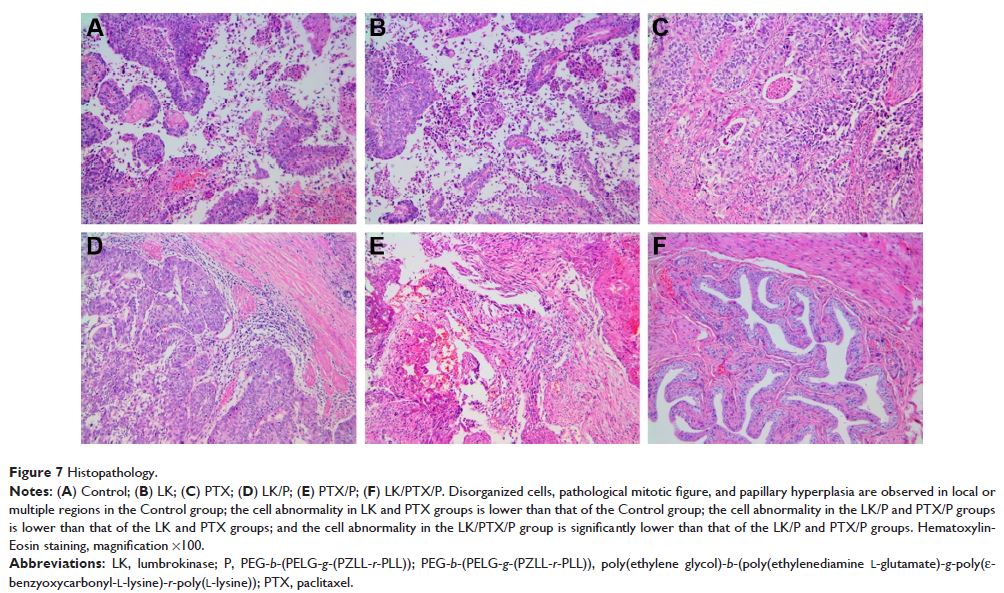9 0 8 0 2
论文已发表
注册即可获取德孚的最新动态
IF 收录期刊
- 2.6 Breast Cancer (Dove Med Press)
- 3.9 Clin Epidemiol
- 3.3 Cancer Manag Res
- 3.9 Infect Drug Resist
- 3.6 Clin Interv Aging
- 4.8 Drug Des Dev Ther
- 2.8 Int J Chronic Obstr
- 8.0 Int J Nanomed
- 2.3 Int J Women's Health
- 3.2 Neuropsych Dis Treat
- 4.0 OncoTargets Ther
- 2.2 Patient Prefer Adher
- 2.8 Ther Clin Risk Manag
- 2.7 J Pain Res
- 3.3 Diabet Metab Synd Ob
- 4.3 Psychol Res Behav Ma
- 3.4 Nat Sci Sleep
- 1.9 Pharmgenomics Pers Med
- 3.5 Risk Manag Healthc Policy
- 4.5 J Inflamm Res
- 2.3 Int J Gen Med
- 4.1 J Hepatocell Carcinoma
- 3.2 J Asthma Allergy
- 2.3 Clin Cosmet Investig Dermatol
- 3.3 J Multidiscip Healthc

蚓激酶/紫杉醇纳米粒子复合物:膀胱癌的潜在治疗应用
Authors Hu B, Yan Y, Tong F, Xu L, Zhu J, Xu G, Shen R
Received 24 February 2018
Accepted for publication 27 April 2018
Published 26 June 2018 Volume 2018:13 Pages 3625—3640
DOI https://doi.org/10.2147/IJN.S166438
Checked for plagiarism Yes
Review by Single-blind
Peer reviewers approved by Dr Alexander Kharlamov
Peer reviewer comments 2
Editor who approved publication: Dr Linlin Sun
Background: Lumbrokinase (LK) is an enzyme complex with antithrombotic, antioxidant,
antitumor, and immunomodulatory effects. It has been extensively studied and
used in clinical anti-tumor therapy. However, its half-life is short, its bioavailability
is low, and its toxicity and side effects are great, which greatly limit its
clinical application. Therefore, LK is often combined with other drugs (such as
immune agents, hormones, or Chinese herbal medicine) to reduce its dosage and
side effects and to improve its anti-tumor effects.
Methods and
results: Here, we described an
LK/paclitaxel (PTX) nanocarrier based on poly(ethylene glycol)-b -(poly(ethylenediamine
l-glutamate)-g -poly(ε-benzyoxycarbonyl-l-lysine)-r -poly(l-lysine)) (PEG-b -(PELG-g -(PZLL-r-PLL))). In the present study, LK
and PTX were loaded by electrostatic and/or hydrophobic effects under mild
conditions, thereby increasing the half-life and bioavailability of the drugs
via the sustained release and enhancement of tumor site enrichment by the
LK/PTX/PEG-b -(PELG-g -(PZLL-r -PLL)) complex through passive
targeting. In this study, using bladder cancer cells (J82 cells) and rat
bladder cancer model as the object, the structure of the nanocarrier, the
relationship between drugs composition and antitumor properties were
systematically studied.
Conclusion: We propose that the block copolymer PEG-b -(PELG-g -(PZLL-r -PLL)) may function as a potent
nanocarrier for augmenting anti-bladder cancer pharmacotherapy, with
unprecedented clinical benefits.
Keywords: copolymer nanoparticles, lumbrokinase, paclitaxel, bladder cancer,
microvessel density, p53, cyclin B1
